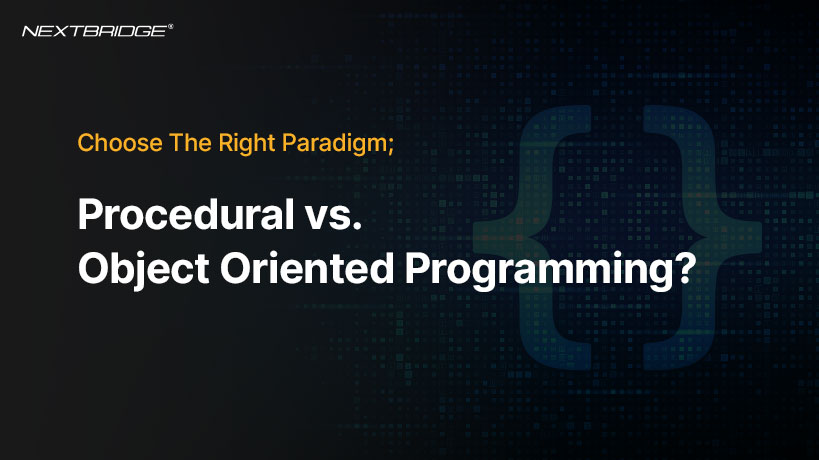 Back to all articles
Back to all articles
Blogs
Choose The Right Paradigm; Procedural vs. Object-Oriented Programming?


Programming languages function as a guideline for a computer, giving it all the operational instructions. Meanwhile, it also ensures that a computer properly understands the codes and executes them accordingly. There are multiple methods an expert can adopt to make instructions effective according to specific programs.
However, among all of them, the debate between two of the most popular ones stands as a fundamental crossroads. Whether you're an aspiring coder seeking your programming path or a seasoned developer navigating the complexities of software design, understanding the nuances of object-oriented vs procedural programming is essential.
What is Object-Oriented Programming?
Out of the many procedures, object-oriented programming is the one that is effective for developing large and complex programs. The term itself consists of the two words Object and Oriented which describes it as highly efficient for simulating real-world events.
The integration of concepts like abstraction, encapsulation, polymorphism, and inheritance makes software development convenient which makes this paradigm famous. Besides, it uses a bottom-up approach making it beneficial for implementing tests, developing problem-specific solutions, and data hiding.
Key Concepts of Object-Oriented Programming
- Objects are real-world entities that interact with each other and encapsulate both attributes and methods.
- Classes define the structure and behavior of their objects which is why they are considered as the blueprints for creating objects.
- Programmers can easily get new classes created using the existing ones which enhances code readability.
- Data encapsulation in the objects maintains data integrity.
- The polymorphism method enhances flexibility and extensibility by treating all objects as a common superclass.
Examples of Object-oriented Programming
- Python is a widely used language that supports OOP. In this example, the Person is being defined with attributes and methods.
- Java is a popular statically-typed OOP language this example defines a Car class with attributes and methods.
- This example of C++ defines a Rectangle class with methods to calculate area and perimeter.
What is Procedural Programming?
As the name of this process itself suggests, procedural programming is a process of creating apps using the code step by step. This method had been derived from the imperative technique and has its roots in structural programming.
When to Use Procedural Programming
- For small, simple projects, procedural programming languages can be more straightforward and easier to implement.
- The linear execution of this programming strategy is beneficial in situations where every bit of performance matter
- Some older systems are built using procedural languages, and it may be necessary to maintain or update them using the same paradigm.
Key Concepts of Procedural Programming
- Procedural programming follows a top-down approach which is effective in linear execution of all operations.
- The blocks of code working as the functions and procedures in this method are responsible for performing specific tasks conveniently.
- Variables can be easily accessed from any platform which impacts data integrity and abstraction.
- Languages like C, Pascal, and Fortran are examples of procedural language.
When to Use Object-Oriented Programming
- OOP's modular and organized structure can simplify the development and maintenance of complex software projects
- When multiple programmers are working on a project, OOP's encapsulation and abstraction can help prevent conflicts and make code more manageable.
- Object-oriented programming mirrors the thinking patterns of human beings which makes it ideal for modeling real-world objects, relationships, and behaviors.
- It maintains code readability while reducing redundancy.
Example of Procedural Programming
- Procedural programming in C for calculating a factorial of the numerical value.
- Example of a Pascal program that calculates the sum of integers from 1 to 10 using a procedural approach.
- Fortran language is mostly used in engineering or scientific apps, here in this example computes the average of an array of numbers using procedural method.
Functional vs. Procedural Programming
It's worth noting that functional programming is another paradigm that differs from both procedural and object-oriented programming. Functional programming revolves around the evaluation of functions and avoids changing state and mutable data. While functional programming has its merits, it's a separate paradigm with its unique characteristics.
Which Paradigm Suits You Best?
The choice between procedural and object-oriented programming, or even a blend of both, depends on the specific requirements of your project and your coding preferences. Consider the following factors when making your decision:
Project Size and Complexity
Procedural programming may be simpler for small projects, while OOP excels in handling complexity.
Team Collaboration
If you're working with a team of developers, OOP's encapsulation and abstraction can help prevent conflicts and make code more manageable.
Modeling Real-World Entities
If your project involves modeling real-world objects and their relationships, OOP is a natural fit.
Code Reusability
OOP promotes code reuse through inheritance and polymorphism, reducing redundancy and enhancing code maintainability.
End Note!
Most programmers get tangled in the procedural vs object-oriented programming loop. However, the debate to determine the most effective one out of the two is mind-boggling but both are advantageous in their own way. OOP is good for dealing with large and complex software projects. Its modular structure, encapsulation, and support ease crafting robust solutions.
Contrary to this, procedural programming is a method that is suitable for sequential operations. Its top-down approach can streamline code development, particularly for performance-critical applications. Both methods are invaluable for your programming arsenal. But you must remember, that the optimal strategy for crafting elegant and efficient software solutions may lie in the balance between these two programming worlds.
Don't hire us right away
talk to our experts first,
Share your challenges, & then decide if we're the right fit for you! Talk to Us
Partnerships & Recognition
Commitment to excellence






